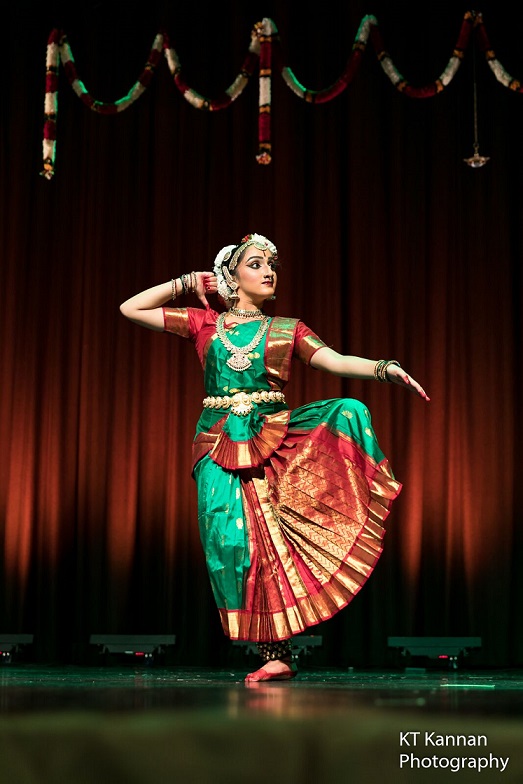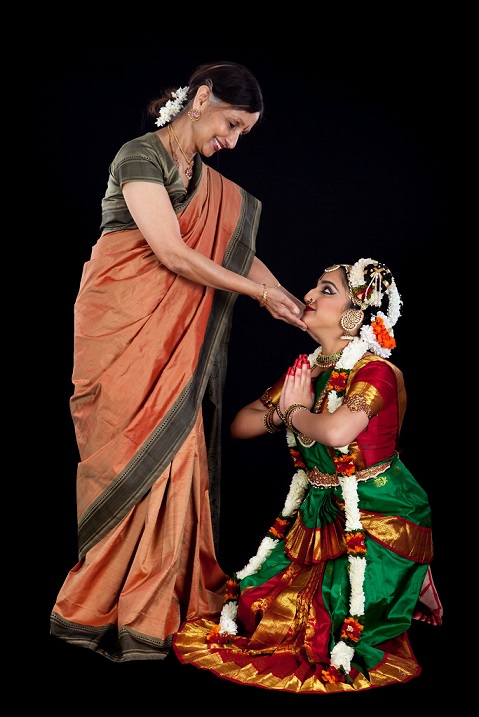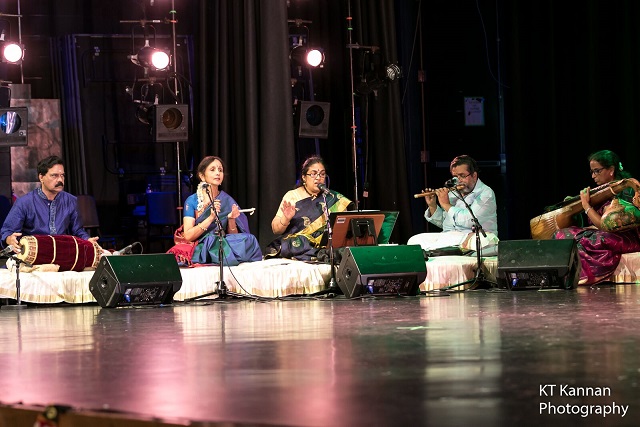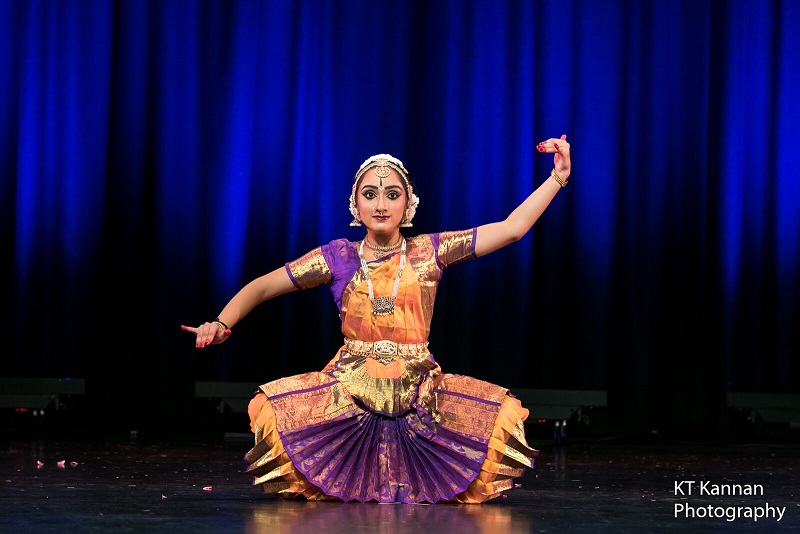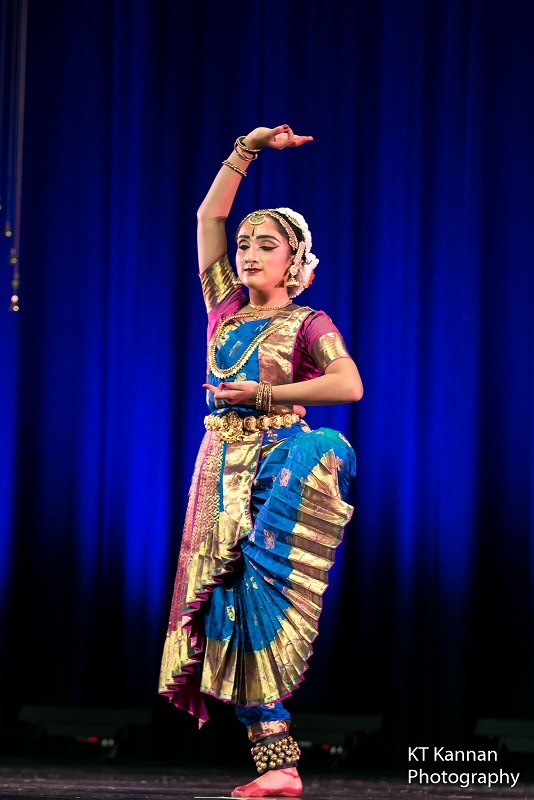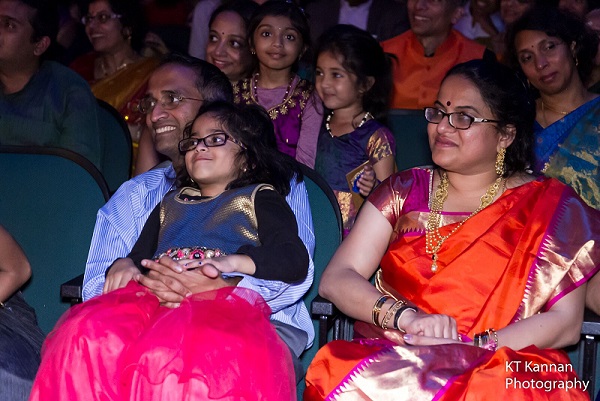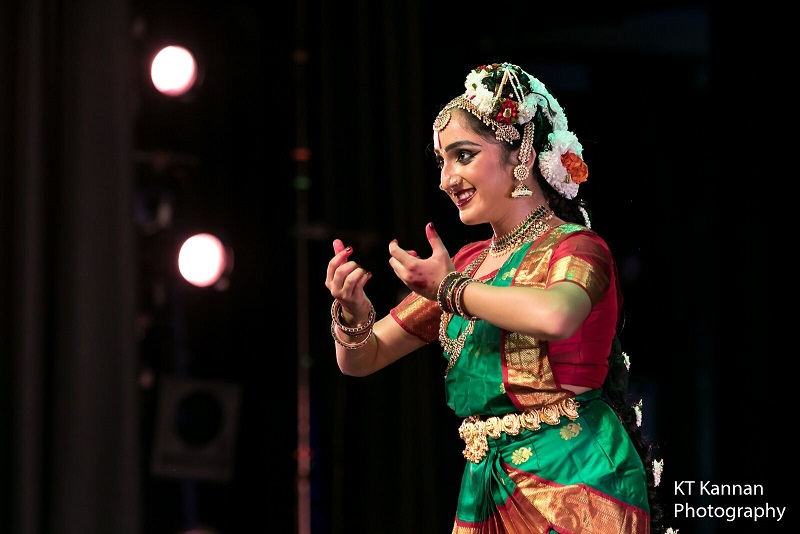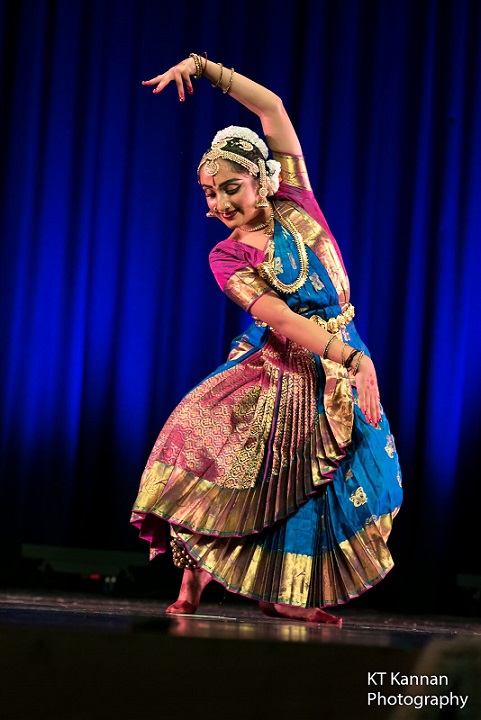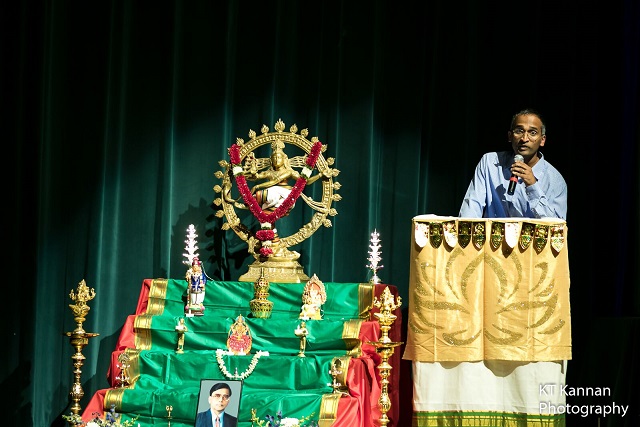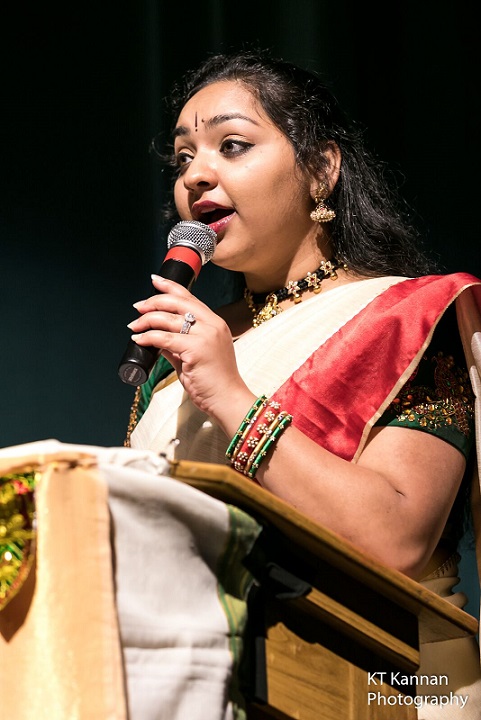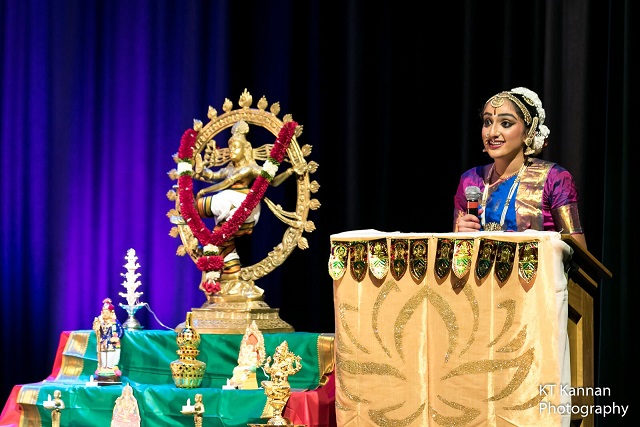Contribute
| Arangetram: Meenakshi Ramakrishnan |
K. Arvind
08/24/2017
Arangetram: Meenakshi Ramakrishnan न तजà¥à¤œà¥à¤žà¤¾à¤¨à¤‚ न तचà¥à¤›à¤¿à¤²à¥à¤ªà¤‚ न सा विदà¥à¤¯à¤¾ न सा कला | na tajgyaanam na tachchilpam na saa vidyaa na saa kalaa | There is no knowledge, no craft, no learning, Meenakshi Ramakrishnan, a talented young student of Guru Smt. Jothi Raghavan, dazzled her audience at the Littleton High School Auditorium on Saturday, August 12, 2017, through her pristine presentation of the Southern Indian classical dance form of bharatanatyam. At this well-attended debut performance that marked her “arangetram†or formal ascent to the dance stage, Meenu demonstrated with great confidence and energy, her proficiency in various aspects of this traditional art form, including graceful movement, complex rhythms, emotive expressions, and sculpturesque poses. The solo dance recital which was structured as a sequence known as “margamâ€, was made even more memorable by the power team of accompanying musicians consisting of Smt. Jothi Raghavan (nattuvangam), Smt. Bhuvana Ganesh (vocal), Smt. Durga Krishnan (veena), Sri H.S. Venugopal (flute) and Sri M. Narayanaswamy (mridangam). THE DANCER - Nartaki Meenakshi (“Meenuâ€) Ramakrishnan, a sophomore at Bromfield High School, Harvard, MA, thoroughly impressed her audience at her bharatanatyam arangetram, which marked her formal ascent to the dance stage after years of demanding training and practice. Meenu’s talent, hard work and commitment, in combination with the expert and loving guidance of her Guru Smt. Jothi Raghavan, who directs the Nrityanjali School of Dance, resulted in a pristine debut performance that the entire community can be proud of. Meenu developed a passion for dance at a very young age, and began her training initially in kuchupudi under Smt. Sumitra Anand when she was 7. She has been learning bharatanatyam under the guidance of Guru Smt. Jothi Raghavan, since the age of 9. Meenu who also takes lessons from Manasa Jayanti, a senior disciple of Smt. Jothi Raghavan, has a deep love for culture and tradition which is evident in her various performances in the area. In addition to bharatanatyam, Meenu studies Carnatic music under Smt. Aparna Balaji. She is also an active athlete, life-guard, kayaker, soccer player, and a Math enthusiast. She is passionate about social justice and participates in various activities and organizations, such as Bromfield Cares. THE DANCE PROGRAM - Margam A leading motif of the program was Devi Meenakshi (Meenu is a namesake of this divinity!), the divine Mother Goddess enshrined in the historic Temple located in Madurai in the state of Tamil Nadu in India. This divine consort of Lord Shiva whose beautiful life-size painting greeted guests at the entrance to the venue, was also the theme of the pièce de ré·sis·tance of the recital, the varnam. The recital itself was organized as a margam (path), a specific sequence of dance pieces selected to demonstrate the mastery and control of the dancer over various elements of the art form including rhythm, movement, energy, and emotive expressiveness. The dance pieces were set to classical music rendered by an elite ensemble of Carnatic musicians, both vocal and instrumental. Guru Smt. Jothi Raghavan herself did the jati (spoken drumbeat syllables) and nattuvangam (cymbals), while Smt. Bhuvana Ganesh excellently rendered various vocal compositions whose meanings were captured and expressed by Meenu via dance. The melodious strings of Smt. Durga Krishnan‘s veena, the mellifluous wind from Sri H.S. Venugopal’s flute, and the resonant beats of Sri N. Narayanswamy’s mridangam (the latter pair traveling from Bengaluru, India) created a divine setting for the dance. Manasa Jayanti’s expert compering helped the audience appreciate the technicalities and subtleties of the dance presentation. The program commenced with a traditional prostration by the dancer to her Guru, elders, and God, seeking their blessings. After formally receiving the anklet bells (salangai) from her Guru, Meenu started with “pushpanjaliâ€, an invocatory dance seeking the grace of Lord Ganesha through an offering of flowers. This piece set to a musical composition of Dr. Balamuralikrishna in raga arabhi provided an energetic start, and was followed by a beautiful short dance in praise of the Goddess of learning and the arts, based on Adi Shankara’s “sharada bhujanga stotramâ€. The next piece known as “alarippu†(“flowering budâ€) consisted of pure dance movements set to jati syllables sung by Smt. Jothi Raghavan, which served as a graceful preparation and warm up (a symbolic “flowering of the limbsâ€) for the more complex pieces that followed. In the “jatiswaram†piece that followed, Meenu danced to rhythmic jati syllables spoken by Smt. Jothi Raghavan, that were interwoven with pure musical swaras (notes) in raga bhairavi sung by Smt. Bhuvana Ganesh, and elegantly demonstrated her grasp of graceful bodily movements and intricate footwork that characterize this dance form. Next came a wonderful musical interlude that included a mesmerizing solo rendering of raga sindhubhairavi on the flute by Sri H.S. Venugopal, a beautiful solo veena rendering of “enna thavam seithanai†in raga kaapi by Smt. Durga Krishnan, and a delightful solo percussion session on the mridangam by Sri Narayanaswamy. The musical interlude was followed by “varnam†– the central and most elaborate piece of the evening. This piece was set to the song “maate malayadhwaja†in raga kamaas, a composition of Sri Muthiah Bhagavathar in praise of Goddess Meenakshi. The song provided a setting to enact various episodes and attributes associated with the Goddess, and Meenu used the setting with seemingly effortless confidence to display her mastery over “nritta†(pure dance), “nritya†(expressive dance) and “natya†(storytelling), core aspects of bharatanatyam. A brief demonstration of the vocabulary of expression (“abhinayaâ€) used in the dance that preceded the piece made the expressive storytelling very comprehensible even to those not deeply familiar with the art – Meenu demonstrated various poses that represented characters such as Goddess Meenakshi, Lord Shiva, Lord Ganesha, Lord Karthikeya, King Malaydhwaja Pandya, incidents such as the King being blessed with child Meenakshi, the Goddess vanquishing the demon Chamunda, and ideas such as proficiency in the arts and in war, etc. With this abhinaya vocabulary in hand, it was easy to follow the story that Meenu conveyed so expressively in this dance piece. The expressive abhinayas, the intricate footwork, the creative improvisations and other aspects of this presentation left no doubt in the mind of the viewer that Meenu has arrived on the stage, and her Guru has worked her magic again on yet another shishyaa! The second half of the program started with a lively dance depicting Lord Nataraja, the dancing form of Lord Shiva, set to “ananda nadamidum padamâ€, a composition by Papanasam Sivam in raga kedaragaula. In the piece that followed and that was set to a Malayalam composition in raga anandabhiravi by Devarajan, Meenu transported the audience to the Temple of Guruvayoor, and charmingly portrayed both Lord Krishna and a devotee who expresses her desire to witness him in the same form that the gopis saw Him. In the next dance set to the Purandara Dasa composition in Kannada, “ada hodalle makkalu†(raga surati), Meenu enthralled the audience as she exquisitely captured the playful mischief of the naughty child Krishna. This was followed by a sparkling “thillana†dance set to a composition of Lalgudi Jayaraman in raga mohanakalyani, in which Meenu once again captivated the audience with her graceful body movements and intricate foot work. The scintillating concert concluded auspiciously with a benedictory mangalam piece. THE AUDIENCE – rasikas The well-attended arangetram attracted an audience, some of whose members came from as far away as India, and that included senior dance and music professionals. Meenu impressed and enthralled everyone in the audience through her brilliant performance. The audience’s only disappointment could perhaps have been that the program had come to an end! Comments from various members of the audience seem to confirm this. Musician and academic Dr. Padma Sugavanam from Chennai, India, noted that “the biggest challenge for a dancer, is to convey the 'bhaava' (feeling) of the piece performed. Even seasoned dancers find 'abhinaya' (expression) challenging - where one needs to convey feelings in unspoken ways, through facial gestures, movements of the eyes etc.â€. She commended Meenu on her “prowess in abhinaya†and praised Guru Smt. Jyoti Raghavan, “the brain behind the program who deserves all credit for guiding her and developing her talents so well." Sapna Krishnan, founder of the Lasya School of Dance, Shrewsbury, MA, complimented Meenu for the “delightful and energetic performance†and remarked that true to the Sanskrit saying "yato hasta tato drishti, yato drishti tato manah, yato manah tato bhava, yato bhava tato rasa", Meenu “immersed the rasikas in the art form.†Aparna Balaji called the arangetram “a beautiful experience†in which “Meenu did full justice to her talent and her Guruâ€, and complimented Meenu on the tremendous “grace and poise exhibited on stage by this young childâ€. Nicole Palmer of Concord MA, who has known Meenu since she was a five-year-old, mentioned that her two children who have studied ballet for 22 years between them, were in awe, and remarked that “every step looked amazing†and “the professionalism of Meenu's performance was impressive.†Manasa Jayanti noted that “Meenu's ability to morph into characters such as the powerful Meenakshi to the innocent kid Krishna was fluid and done with immense ease. She has taken all of her feedback from class and has used to it her advantage as positive criticism that helped her develop strength in the characters she performed and sharpened her technique of the nritta aspect of bharatanatyamâ€. Bharatanatyam exponent Anusha Sivaramakrishnan, Director of the Rhythms Dance School in New Jersey, congratulated Meenu on “the great job†she did, and observed that “the key highlight was her expressions depicting the different stories from goddess Meenakshi to Lord Krishna. She demonstrated versatility depicting different bhavas and was able to connect with the audienceâ€. Dancer Krithi Tupil, a disciple of Guru Sunanda Narayan, termed this an “incredible performance†and noted that “Meenu’s dance reflected all the hard work, dedication and passion she poured into itâ€. Marni Kaplan Earle of Acton who termed the arangetram program “an honor to witness†felt that “Meenu embodied the concept of mastery: profound dedication of body, mind and spirit and pure joy." A PROUD MOMENT Guru Smt. Jothi Raghavan told me, “Meenu worked very hard preparing for her arangetram and did an amazing job. I'm very proud of herâ€. This arangetram is a cherished moment of well-deserved pride not only for Guru Smt. Jothi Raghavan, but also for Meenu, her family, especially her parents Smt. Anju Ramakrishnan and Dr. Balasubramanian Ramakrishnan, and friends. Meenu’s arangetram was the final arangetram for this summer from the Nrityanjali School of Dance, which is celebrating its 40th year of service, and was a great way to end the summer. We wish Meenu the very best in her dancing career!
नासौ योगो न ततà¥à¤•à¤°à¥à¤® नाटà¥à¤¯à¥‡à¤½à¤¸à¥à¤®à¤¿à¤¨à¥ यनà¥à¤¨à¤¦à¥ƒà¤¶à¥à¤¯à¤¤à¥‡ ||
naasau yogo na tat karma naatyesmin yannadrushyate ||
no art, no action that is not found in dance
(Bharata Muni’s Natyashastra (I.116))
You may also access this article through our web-site http://www.lokvani.com/
